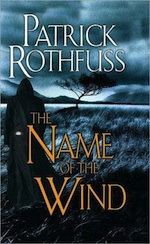If you wear a false identity long enough, is it still false? What makes up one’s identity, anyway? When enough time has passed, don’t you become, at least partially, that which you were once only pretending to be?
The five books I’ve selected explore these questions—often in very roundabout ways. The obvious choice for this list would be spy books, but I’ve only included one of those. The rest are fantasy, historical and science fiction.
We discover, working through the list, that sometimes a false identity is truly false, sometimes it becomes real, and sometimes it hovers in the gray area in between.
 Cloud Atlas by David Mitchell
Cloud Atlas by David Mitchell
In David Mitchell’s masterpiece, six nested stories take us from the South Pacific in the 1800s all the way to a post-apocalyptic future, calling into question the meaning of personal identity and asking if our essence—our souls—live on again and again.
 The Name of the Wind by Patrick Rothfuss
The Name of the Wind by Patrick Rothfuss
It might be a stretch to include this book on this particular list, but I was especially affected by the time the hero, Kvothe, spent alone in the woods and then his years as a street urchin. With the traumatic death of his parents, Kvothe loses his place in the world, and with it his identity. He essentially becomes someone else for a very long time, until he recovers enough of who he is to move forward with his life.
 The Diamond Age by Neal Stephenson
The Diamond Age by Neal Stephenson
This is one of my favorite books of all time. It could also be included in a list of “books with tapestries so rich and complicated, no one will ever be able to adapt them into a film.” (No matter what list you put this book on, you should absolutely read it!) In The Diamond Age, Nell slowly grows up and stumbles through identities as she becomes associated with different tribes, or “phyles,” before fully coming into her own and choosing both who she wants to associate with and her own identity by the end of the story.
 Ready Player One by Ernest Cline
Ready Player One by Ernest Cline
A book entirely wrapped up in false identities. In the year 2045, everyone participates in the OASIS, a virtual reality universe that distracts from the awful conditions of the real world. As readers, we experience most of the story through the online avatars of the characters involved. Here false and true identities are enmeshed in ways that are difficult to separate—or to put it a different way, the false identities are a vital element of the heroes’ own selves.
 Code Name Verity by Elizabeth Wein
Code Name Verity by Elizabeth Wein
When a spy—a young woman—ends up captured and tortured by the enemy in WWII France, the reader must grapple with the hero’s (or should I say anti-hero’s?) identity. Does she remain true to who she was, or has she sacrificed all of her ideals in order to survive?
 In my novel Seeker, characters also struggle with identity. In the Scotland and Hong Kong of the near future, three teens have spent years undergoing brutal training to become noble Seekers, committed to making the world better and more fair. But the adults they trust most are manipulating them, lying to them. Instead of the noble calling they’ve imagined, they are being turned into terrible people and forced to do very bad things. The story escalates from there…
In my novel Seeker, characters also struggle with identity. In the Scotland and Hong Kong of the near future, three teens have spent years undergoing brutal training to become noble Seekers, committed to making the world better and more fair. But the adults they trust most are manipulating them, lying to them. Instead of the noble calling they’ve imagined, they are being turned into terrible people and forced to do very bad things. The story escalates from there…
Arwen Elys Dayton spends months doing research for her stories. Her explorations have taken her around the world to places like the Great Pyramid at Giza, Hong Kong and its many islands, and lots of ruined castles in Scotland. Arwen lives with her husband and their three children on West Coast of the United States. You can visit follow her on Twitter @arwenelysdayton.










